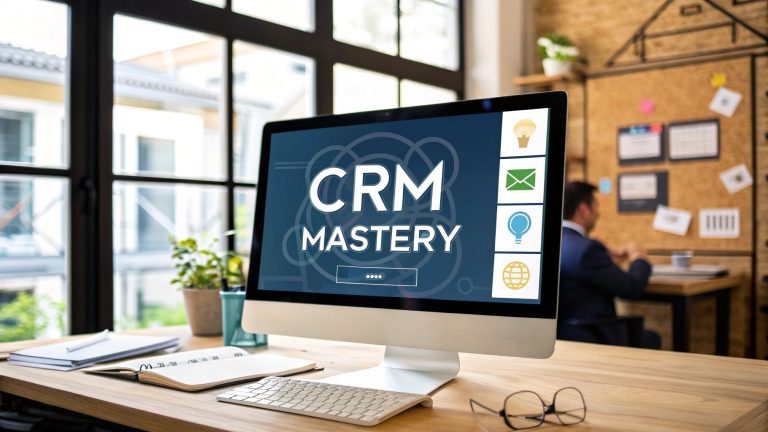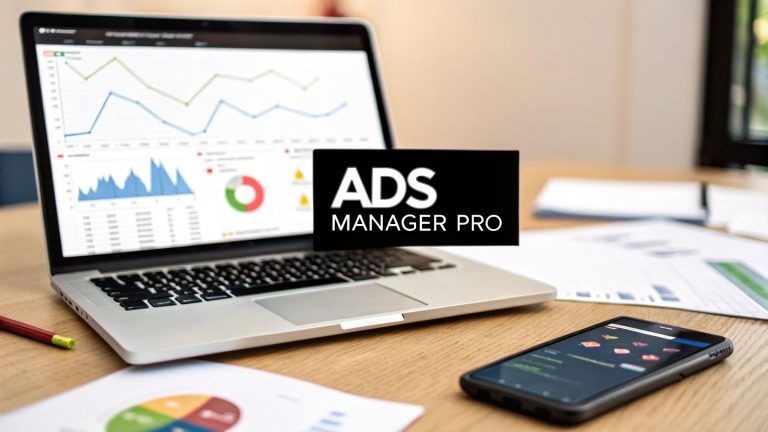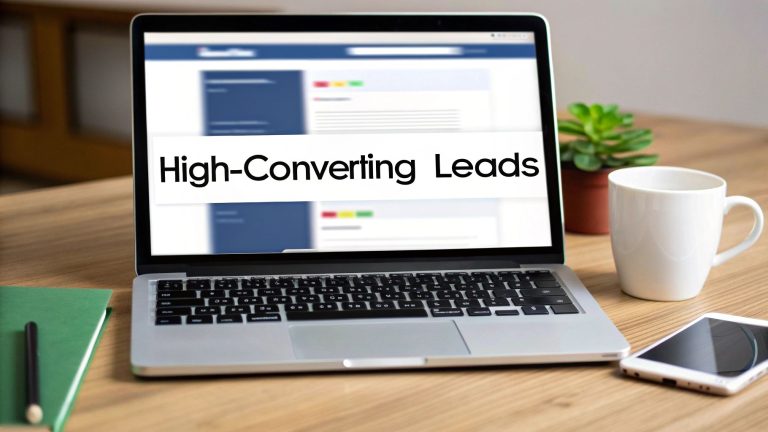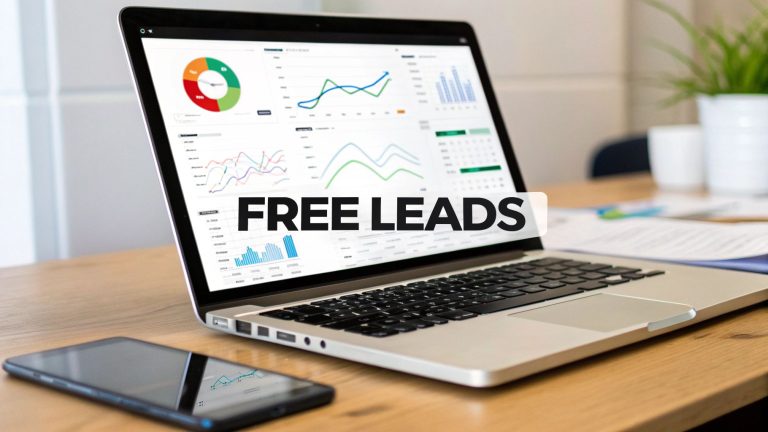Top Lead Generation KPIs to Boost Your Marketing in 2025
Fueling Your Sales Pipeline: Mastering Lead Generation Metrics
Effective lead generation hinges on attracting the right leads. This comprehensive guide explores seven essential lead generation KPIs you must track in 2025 to refine your campaigns and boost revenue. We'll dissect each KPI, providing clear definitions, industry benchmarks, tracking advice, and actionable strategies for maximizing conversions.
This listicle provides a deep dive into the following key lead generation KPIs:
- Lead Conversion Rate: Understand how effectively your marketing efforts are turning visitors into leads.
- Cost Per Lead (CPL): Track the financial efficiency of your lead generation campaigns.
- Lead Quality Score: Measure the likelihood of leads converting into paying customers.
- Lead-to-Customer Conversion Time: Analyze the duration of your sales cycle and identify bottlenecks.
- Marketing Qualified Leads (MQL) Rate: Determine the percentage of leads ready for sales engagement.
- Sales Qualified Leads (SQL) Rate: Assess the number of MQLs that progress to become sales-ready opportunities.
- Lead Response Time: Evaluate the speed of your team's response to incoming leads.
By mastering these lead generation KPIs, you'll gain valuable insights into your marketing performance and unlock opportunities for improvement. This data-driven approach empowers your team to optimize campaigns, allocate resources effectively, and ultimately drive significant revenue growth. Let's transform your lead generation into a predictable, high-performing engine.
1. Lead Conversion Rate
Lead conversion rate is a crucial lead generation KPI that reveals the effectiveness of your entire sales funnel. It measures the percentage of leads that ultimately convert into paying customers. This metric goes beyond simply generating leads; it gauges how well you nurture and guide those leads toward a purchase. Tracking lead conversion rate helps identify bottlenecks in your process and optimize strategies for maximizing revenue. This KPI provides a clear picture of how effectively your marketing and sales efforts are working together to drive business growth.
Why Track Lead Conversion Rate?
Understanding your lead conversion rate is essential for several reasons:
- Return on Investment (ROI) Measurement: It directly ties your lead generation efforts to revenue, allowing you to accurately assess the ROI of your campaigns.
- Sales Process Optimization: By identifying stages with low conversion rates, you can pinpoint areas for improvement in your sales process.
- Marketing Effectiveness Evaluation: It helps evaluate the quality of your leads and the effectiveness of your marketing strategies in attracting qualified prospects.
- Resource Allocation: By understanding which lead sources and campaigns yield the highest conversion rates, you can allocate your resources more efficiently.
Examples of Success
Several companies have demonstrably improved their performance by focusing on lead conversion rate. HubSpot reports that the average lead conversion rate across industries is 2.35%. This benchmark provides a useful starting point for comparison. However, some businesses achieve significantly higher rates. For example, Salesforce improved its conversion rates by 27% using lead scoring automation. Similarly, Marketo customers commonly experience 3-5x higher conversion rates by implementing lead nurturing campaigns.
Tips for Improving Lead Conversion Rate
Optimizing your lead conversion rate requires a multi-faceted approach. Here are some actionable tips:
- Implement robust lead tracking: Track your leads from the initial point of contact through the entire sales cycle to closing. This comprehensive tracking allows you to identify drop-off points and understand the customer journey.
- Segment your leads: Categorize your leads based on source, demographics, behavior, and other relevant factors. Segmenting allows for more targeted and effective nurturing strategies.
- Use lead scoring: Prioritize leads based on their likelihood to convert. Lead scoring helps your sales team focus on high-potential prospects, improving efficiency and conversion rates.
- A/B test landing pages and lead magnets: Continuously optimize your landing pages and lead magnets to improve conversion rates. Experiment with different headlines, calls to action, and content to find what resonates best with your target audience.
The following bar chart visualizes typical lead conversion rate benchmarks across different industry sectors.
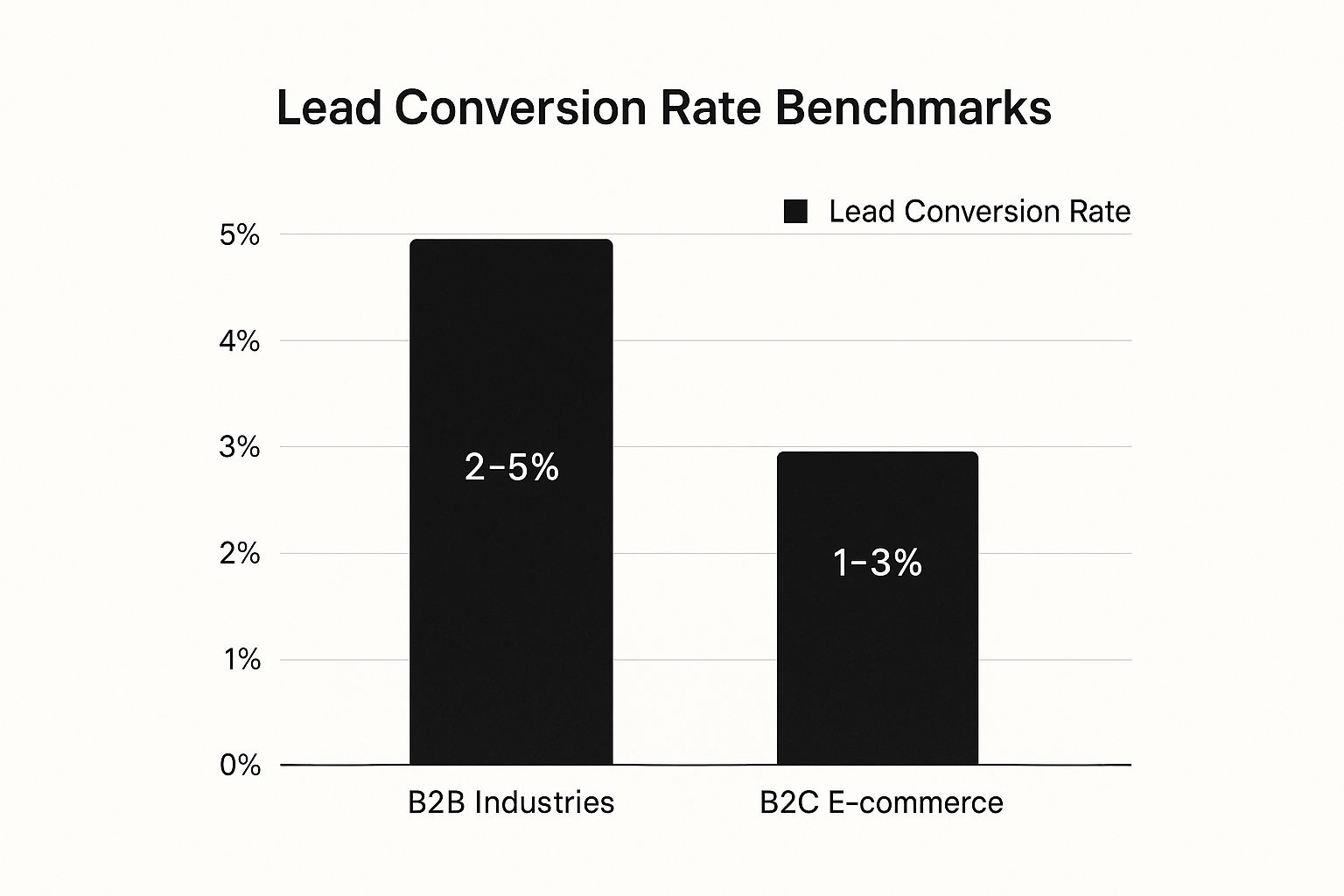
As the 'Lead Conversion Rate Benchmarks' chart demonstrates, B2B industries generally have lead conversion rates between 2-5%, while B2C e-commerce businesses see rates between 1-3%. This difference highlights the importance of understanding industry benchmarks when setting conversion rate goals and evaluating performance. Tracking and optimizing this key metric is fundamental to achieving sustainable growth and maximizing the return on your marketing and sales investments.
2. Cost Per Lead (CPL)
Cost Per Lead (CPL) is a critical lead generation KPI that measures the average amount spent on acquiring a single lead across all your marketing channels. This metric provides valuable insights into the efficiency of your lead generation efforts. By understanding your CPL, you can make informed decisions about budget allocation and optimize campaigns for maximum return on investment. Tracking CPL ensures you're directing resources toward the most cost-effective channels and strategies.

Why Track Cost Per Lead?
Monitoring your CPL offers several key advantages:
- Budget Optimization: Identify which channels and campaigns provide the lowest CPL, allowing you to allocate budget effectively.
- Campaign Efficiency: Measure the effectiveness of different marketing strategies and make data-driven adjustments to improve performance.
- Profitability Analysis: Understanding your CPL helps you determine the profitability of your lead generation efforts and set realistic revenue goals.
- Predictive Modeling: Track CPL trends over time to forecast future lead generation costs and proactively adjust your budget.
Examples of Success
Understanding industry benchmarks for CPL is crucial. Google Ads reports average CPLs of $53 for B2B and $34 for B2C. LinkedIn advertising typically sees CPLs between $75 and $100 for B2B companies. Content marketing can achieve CPLs as low as $92, contrasting sharply with the higher costs associated with trade shows, which can reach $619. By analyzing these benchmarks and comparing them to your own CPL, you can identify areas for optimization.
Tips for Improving Cost Per Lead
Lowering your CPL requires a strategic and data-driven approach:
- Channel-Specific Tracking: Monitor CPL for each individual marketing channel and campaign to pinpoint areas of inefficiency.
- Quality over Quantity: Balance CPL with lead quality metrics to ensure you're not simply generating low-value leads.
- Multi-Touch Attribution: Implement multi-touch attribution modeling to accurately allocate costs across various touchpoints in the customer journey.
- Value-Based Targeting: Set CPL targets based on customer lifetime value (CLTV) calculations to ensure profitability.
Tracking and optimizing CPL is a fundamental aspect of successful lead generation. By understanding this key metric and implementing the tips provided, you can maximize your marketing ROI and drive sustainable business growth. It is a crucial element within the broader context of lead generation KPIs.
3. Lead Quality Score
Lead quality score is a crucial lead generation KPI that predicts the likelihood of a lead converting into a paying customer. It uses a combination of demographic, behavioral, and firmographic data to assign a numerical value to each lead, representing their sales-readiness. This scoring system empowers sales teams to prioritize high-potential prospects, improving efficiency and driving higher conversion rates. By focusing on leads with the highest scores, businesses can optimize their sales process and allocate resources more effectively. This ultimately maximizes the return on investment in lead generation efforts.
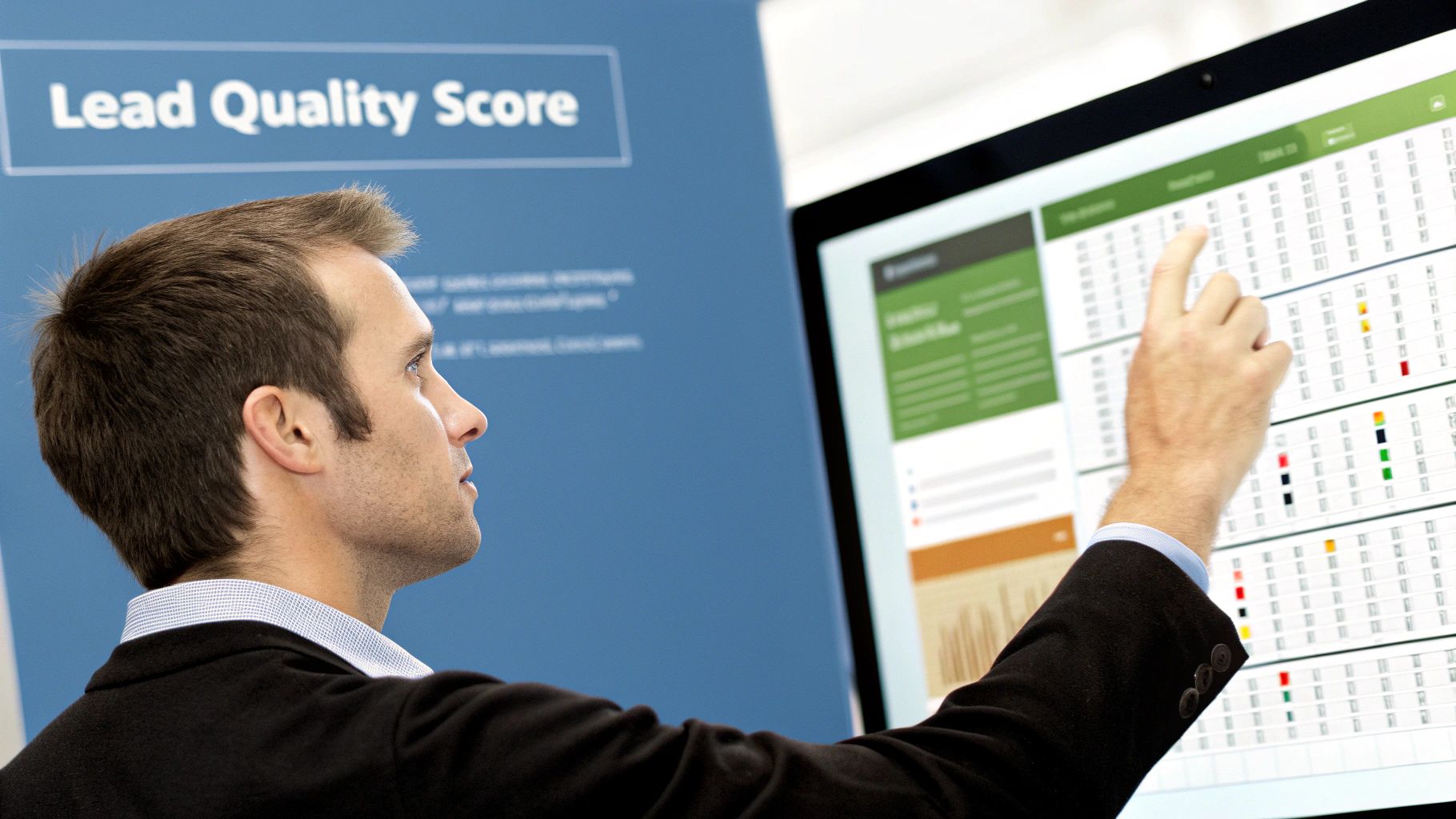
Why Track Lead Quality Score?
Tracking lead quality score offers several key benefits:
- Improved Sales Efficiency: Sales teams can prioritize high-scoring leads, reducing time spent on unqualified prospects and increasing the likelihood of closing deals.
- Increased Conversion Rates: Focusing on high-potential leads naturally leads to higher conversion rates, as sales efforts are directed towards the most promising prospects.
- Better Resource Allocation: Lead scoring helps allocate marketing and sales resources more effectively, ensuring that efforts are focused on the leads most likely to generate revenue.
- Enhanced Revenue Generation: By prioritizing qualified leads, businesses can accelerate the sales cycle and drive higher revenue growth. Learn more about Lead Quality Score and CRM.
Examples of Success
Several companies have achieved remarkable results by implementing lead scoring:
- Marketo: Helped Schneider Electric increase qualified leads by 80% through effective lead scoring.
- Pardot: Users report a 77% increase in lead generation ROI by utilizing lead scoring to prioritize sales efforts.
- Act-On: Customers have seen a 451% increase in qualified leads through proper lead scoring implementation.
These examples demonstrate the significant impact lead scoring can have on lead generation performance.
Tips for Improving Lead Quality Score
Optimizing your lead quality score requires a strategic approach:
- Start simple: Begin with basic demographic and behavioral criteria, such as job title, industry, and website activity.
- Regularly review and adjust: Continuously analyze conversion data and refine your scoring model based on what factors correlate with successful conversions.
- Include negative scoring: Deduct points for behaviors that indicate a low likelihood of conversion, such as unsubscribing from emails or visiting job boards.
- Train your sales team: Ensure your sales team understands how to interpret and utilize lead scores effectively to prioritize their outreach.
By implementing these tips, businesses can leverage lead quality score as a powerful tool to improve lead generation ROI and drive sustainable revenue growth. This KPI provides a valuable framework for identifying, prioritizing, and nurturing high-potential leads, ultimately maximizing sales effectiveness and business success.
4. Lead-to-Customer Conversion Time
Lead-to-customer conversion time is a vital lead generation KPI that measures the average time it takes for a lead to move through your sales funnel and become a paying customer. This metric provides valuable insights into the efficiency of your sales process and enables accurate revenue forecasting. By understanding your average conversion time, you can identify bottlenecks, optimize your strategies, and set realistic expectations for sales growth. Tracking this KPI is essential for businesses seeking to accelerate their sales cycle and improve overall revenue performance.
Why Track Lead-to-Customer Conversion Time?
Monitoring lead-to-customer conversion time offers several key advantages:
- Sales Cycle Efficiency: It helps pinpoint slowdowns in your sales process, allowing you to optimize stages and streamline the customer journey.
- Revenue Forecasting Accuracy: Knowing your average conversion time enables more precise revenue projections, facilitating better financial planning and resource allocation.
- Sales Team Performance Evaluation: This KPI helps assess the effectiveness of your sales team’s efforts and identify areas for improvement in their performance.
- Resource Optimization: By understanding how long it takes to convert leads, you can allocate resources more effectively, prioritizing high-potential leads and optimizing marketing spend.
Examples of Success
Many businesses have achieved significant improvements by focusing on lead-to-customer conversion time. B2B SaaS companies typically experience average conversion cycles of 84 days. However, by implementing lead response optimization strategies, companies like InsideSales.com have reduced their average sales cycle by 18%. Salesforce has reported a 30% faster deal closure rate through effective lead nurturing. These examples demonstrate the potential for significant improvements by optimizing conversion time.
Tips for Improving Lead-to-Customer Conversion Time
Reducing your lead-to-customer conversion time requires a strategic approach. Here are some actionable tips:
- Track Conversion Time by Source and Quality: Analyze conversion times based on lead source and lead quality score. This allows you to identify high-performing sources and prioritize leads with higher conversion potential.
- Identify and Address Bottlenecks: Analyze your sales process to identify stages that contribute to delays. Streamline these bottlenecks to accelerate the customer journey.
- Implement Automated Nurturing: Use automated lead nurturing campaigns tailored to different stages of the sales cycle. This ensures consistent engagement and moves leads efficiently through the funnel.
- Set Up Alerts for Stalled Leads: Implement alerts for leads that exceed typical conversion timeframes. This allows your sales team to proactively re-engage with these leads and prevent them from becoming inactive.
Optimizing your lead-to-customer conversion time is critical for achieving sustainable revenue growth. By tracking this key lead generation KPI and implementing the suggested strategies, you can accelerate your sales cycle, improve sales team performance, and maximize your return on investment.
5. Marketing Qualified Leads (MQL) Rate
Marketing Qualified Leads (MQL) rate is a crucial lead generation KPI that measures the percentage of total leads that transition into Marketing Qualified Leads. These are prospects who have demonstrated sufficient interest and fit with your ideal customer profile to warrant further marketing investment and nurturing. Tracking MQL rate allows you to gauge the effectiveness of your marketing strategies in attracting and qualifying potential customers. A strong MQL rate indicates a healthy top-of-funnel performance and efficient lead qualification processes.
Why Track Marketing Qualified Leads (MQL) Rate?
Monitoring your MQL rate is essential for a number of key reasons:
- Sales & Marketing Alignment: A clearly defined MQL process fosters better alignment between sales and marketing teams, ensuring both groups are working towards shared goals.
- Pipeline Predictability: Tracking MQLs helps you predict future sales pipeline potential and allocate resources effectively.
- Marketing ROI Measurement: MQL rate provides valuable insights into the effectiveness of your marketing campaigns and the return on your marketing investments.
- Lead Nurturing Effectiveness: By analyzing MQL conversions, you can determine how effectively your lead nurturing campaigns are moving prospects closer to a sales-ready state.
Examples of Success
Several companies have reported significant improvements in performance by focusing on their MQL rate. HubSpot reports that companies with well-defined MQL processes see 56% higher conversion rates. Marketo, another prominent marketing automation platform, found that their customers achieve 9.3% higher sales quota achievement with robust MQL tracking. Further studies have shown that companies with clearly defined MQL criteria experience 67% more closed deals.
Tips for Improving Marketing Qualified Leads (MQL) Rate
Boosting your MQL rate requires a strategic approach. Here are some practical tips to consider:
- Collaborate with Sales: Work closely with the sales team to define clear and measurable MQL criteria that align with your target customer profile.
- Regular Review and Refinement: Periodically review and refine your MQL qualification standards to ensure they remain relevant and effective.
- Implement Lead Scoring: Utilize lead scoring to automate the MQL identification process, prioritizing leads based on their engagement and fit.
- Track MQL-to-SQL Conversion: Monitor the conversion rate of MQLs to Sales Qualified Leads (SQLs) to validate the effectiveness of your MQL criteria. Learn more about MQLs and how they impact automated lead nurturing here: Learn more about…
By focusing on attracting the right leads and nurturing them effectively, you can significantly improve your MQL rate and ultimately drive more revenue for your business. This KPI is a valuable tool for assessing the health of your lead generation engine and optimizing your marketing and sales efforts for maximum impact.
6. Sales Qualified Leads (SQL) Rate
Sales Qualified Leads (SQL) rate is a critical lead generation KPI that measures the percentage of leads deemed ready for direct sales engagement. These leads have been vetted by the sales team and determined to have the budget, authority, need, and timeline (BANT) to make a purchase. Tracking your SQL rate provides insights into the effectiveness of your lead qualification process and its impact on sales pipeline health. This KPI helps focus sales efforts on the most promising prospects, leading to increased efficiency and higher conversion rates.
Why Track Sales Qualified Leads (SQL) Rate?
Monitoring your SQL rate is crucial for several key reasons:
- Predictive Sales Performance: SQL rate serves as a leading indicator of future sales revenue, allowing for more accurate forecasting and resource allocation.
- Sales Team Efficiency: Focusing on qualified leads empowers sales teams to prioritize their efforts and avoid wasted time on unqualified prospects.
- Improved Close Rates: By targeting leads with a higher likelihood of conversion, SQLs contribute significantly to improved close rates and overall sales performance.
- Marketing and Sales Alignment: Tracking SQLs facilitates better communication and collaboration between marketing and sales teams, ensuring lead quality and efficient handoff processes.
Examples of Success
Several organizations have demonstrated significant improvements by prioritizing SQL qualification. Companies with well-defined SQL processes report 36% higher customer retention rates. Salesforce has documented 25% shorter sales cycles through proper SQL qualification. Similarly, Pardot customers have achieved 34% higher win rates by diligently tracking and managing their SQLs. These examples highlight the impact of focusing on high-quality leads.
Tips for Improving Sales Qualified Leads (SQL) Rate
Optimizing your SQL rate requires a strategic approach and close collaboration between sales and marketing. Here are some effective strategies:
- Establish clear qualification criteria: Define specific BANT (Budget, Authority, Need, Timeline) or MEDDIC (Metrics, Economic buyer, Decision criteria, Decision process, Identify pain, Champion) criteria for qualifying leads. This ensures consistent evaluation and reduces subjective judgment.
- Provide comprehensive lead context: Equip your sales team with detailed information about each lead, including their interactions with your website, marketing materials, and previous communications. This context empowers them to make informed qualification decisions.
- Implement feedback loops: Encourage regular communication between sales and marketing teams to refine lead qualification criteria and improve lead nurturing strategies. This continuous feedback loop enhances lead quality and alignment.
- Track SQL-to-close conversion rates: Monitor the conversion rate of SQLs to closed deals to identify bottlenecks in the sales process and optimize strategies for maximizing conversions. This data-driven approach ensures continuous improvement.
Tracking and optimizing your Sales Qualified Lead rate is essential for lead generation kpis and maximizing sales efficiency. By focusing on high-potential prospects, you can significantly improve close rates, shorten sales cycles, and drive sustainable revenue growth.
7. Lead Response Time
Lead response time is a critical lead generation KPI that measures the average time it takes for your sales team to respond to a new lead after they've expressed interest or submitted their contact information. This metric is crucial because speed-to-lead significantly impacts conversion rates. A slow response can lead to lost opportunities, as prospects may move on to competitors who engage them more quickly. Tracking and optimizing lead response time is essential for maximizing your lead generation efforts and improving sales performance.

Why Track Lead Response Time?
The importance of tracking lead response time cannot be overstated. A prompt response can significantly improve your chances of qualifying a lead.
- Increased Conversion Rates: Studies have shown a direct correlation between faster response times and higher conversion rates. Quick engagement demonstrates responsiveness and builds rapport with potential customers.
- Improved Lead Qualification: Engaging leads quickly allows you to qualify them while their interest is high, leading to more efficient use of sales resources.
- Competitive Advantage: In today's fast-paced business environment, a quick response can set you apart from competitors and position you as a proactive and customer-centric organization.
- Enhanced Customer Experience: Responding promptly shows respect for the lead's time and creates a positive first impression, contributing to a better overall customer experience.
Examples of Success
Research by InsideSales.com has shown that responding to a lead within 5 minutes increases conversion probability by a staggering 900%. Companies that respond within 1 hour are 7 times more likely to qualify leads than those who take longer. A Harvard Business Review study found that leads contacted within 1 hour are 60 times more likely to convert compared to those contacted after 24 hours or more. These statistics underscore the significant impact of a rapid response on lead conversion.
Tips for Improving Lead Response Time
Several strategies can help optimize lead response time and improve conversion rates.
- Automated Lead Alerts and Notifications: Implement a system that automatically alerts sales representatives of new leads in real-time.
- Round-Robin Lead Assignment: Distribute leads evenly and quickly across the sales team using a round-robin assignment system. This ensures that leads are promptly attended to by an available representative. Learn more about lead routing software strategies to improve response times.
- Chatbots for Immediate Response: Use chatbots to provide instant initial responses and gather preliminary information from leads. This can buy valuable time while a sales representative prepares for a more personalized interaction.
- Track and Gamify Response Times: Monitor and track response times across the sales team. Consider implementing gamification strategies to incentivize faster responses and create a competitive environment.
By prioritizing lead response time as a key lead generation KPI, businesses can significantly improve their ability to convert leads into paying customers. Tracking, analyzing, and optimizing this metric is essential for maximizing sales efficiency and achieving sustainable growth.
Lead Generation KPIs Comparison Table
| KPI | Implementation Complexity 🔄 | Resource Requirements ⚡ | Expected Outcomes 📊 | Ideal Use Cases 💡 | Key Advantages ⭐ |
|---|---|---|---|---|---|
| Lead Conversion Rate | Medium – requires lead tracking and attribution setup | Moderate – tracking tools and CRM integration | High – direct impact on revenue and ROI | Evaluating overall sales effectiveness and marketing ROI | Clear revenue correlation, easy to communicate |
| Cost Per Lead (CPL) | Low to Medium – basic spend and lead tracking | Low to Moderate – marketing analytics platforms | Medium – cost efficiency insights | Budget optimization and channel performance analysis | Helps optimize spend, easy benchmarking |
| Lead Quality Score | High – complex scoring model setup and data analysis | High – advanced analytics, CRM, and behavioral data | High – improved lead prioritization and conversion rates | Prioritizing sales efforts and improving targeting | Drives sales efficiency and aligns teams |
| Lead-to-Customer Conversion Time | Medium – requires multi-stage funnel tracking | Moderate – CRM data and process monitoring | Medium – sales process optimization and forecasting | Improving sales cycle and identifying bottlenecks | Enhances sales process efficiency and forecasting accuracy |
| Marketing Qualified Leads (MQL) Rate | Medium – defining criteria and alignment | Moderate – marketing automation and lead scoring tools | Medium – better marketing-sales alignment and nurture outcomes | Marketing campaign effectiveness and lead handoff | Improves lead qualification and campaign focus |
| Sales Qualified Leads (SQL) Rate | Medium to High – sales validation process required | Moderate – sales coordination and CRM inputs | High – stronger pipeline and forecasting accuracy | Final lead vetting before sales engagement | Focuses sales on highest-quality leads, improves pipeline accuracy |
| Lead Response Time | Medium – tracking and alerting implementation | Moderate – CRM integration, communication tools | Very High – rapid response boosts conversions dramatically | Speed-critical sales follow-ups and customer engagement | Significantly increases conversion rates, competitive edge |
From Metrics to Mastery: Optimizing Your Lead Generation KPIs
This comprehensive guide has explored seven essential lead generation KPIs: Lead Conversion Rate, Cost Per Lead (CPL), Lead Quality Score, Lead-to-Customer Conversion Time, Marketing Qualified Leads (MQL) rate, Sales Qualified Leads (SQL) rate, and Lead Response Time. Understanding and tracking these metrics is critical for any business seeking to optimize its lead generation efforts. By analyzing these KPIs, you can identify strengths, pinpoint weaknesses, and unlock opportunities for significant growth.
The Power of Actionable Insights
The true power of these lead generation KPIs lies in their ability to provide actionable insights. Each metric offers a unique perspective on your lead generation funnel. For example, a high CPL might indicate the need to refine your targeting or explore more cost-effective channels. A low lead quality score might suggest a disconnect between your marketing message and your ideal customer profile.
Data-Driven Decisions for Lead Generation Success
Analyzing these metrics isn't about collecting numbers for the sake of it. It's about using data to drive informed decisions that improve your bottom line. By understanding how each KPI interacts with the others, you gain a holistic view of your lead generation ecosystem. This enables you to implement targeted strategies and optimize campaigns for maximum impact.
Continuous Improvement: The Key to Sustainable Growth
Lead generation isn't a set-it-and-forget-it process. It's about continuous improvement, constant refinement, and adapting to the ever-changing market dynamics. Regularly reviewing your lead generation KPIs helps you stay agile, identify emerging trends, and refine your approach for long-term success. This consistent focus on data-driven optimization is the key to sustainable growth in today's competitive landscape.
Beyond the Metrics: Achieving Lead Generation Mastery
Mastering lead generation KPIs is more than just understanding their definitions. It’s about leveraging these metrics to fuel strategic decision-making. By focusing on consistent tracking, analysis, and refinement, you can transform data into actionable intelligence. This allows you to not only generate more leads, but also to attract higher quality leads that are more likely to convert into paying customers. In the digital age, where data is king, this data-driven approach is essential for thriving.
This empowered approach to lead generation can transform your sales pipeline. By making informed adjustments based on your KPI data, you can significantly improve your conversion rates, reduce your cost per acquisition, and ultimately drive revenue growth. This translates to a healthier, more sustainable business model positioned for long-term success.
Ready to streamline your lead generation tracking and analysis? LeadSavvy Pro helps you automate key aspects of lead management, providing valuable insights into your lead generation KPIs. Visit LeadSavvy Pro today to discover how it can help you optimize your lead generation efforts and unlock your full sales potential.


